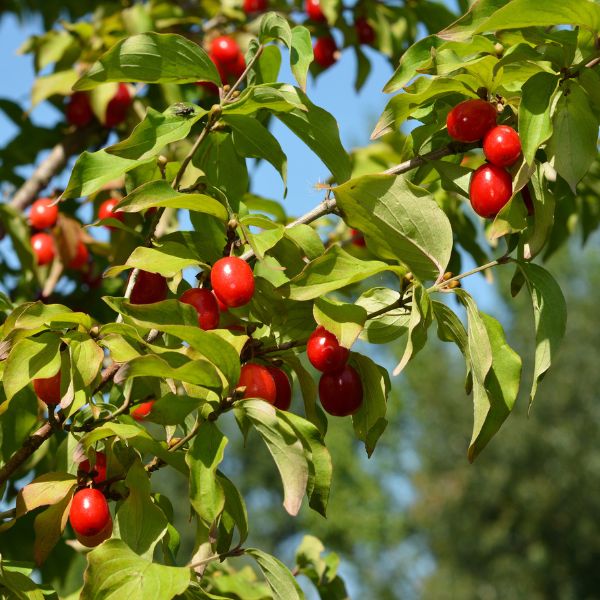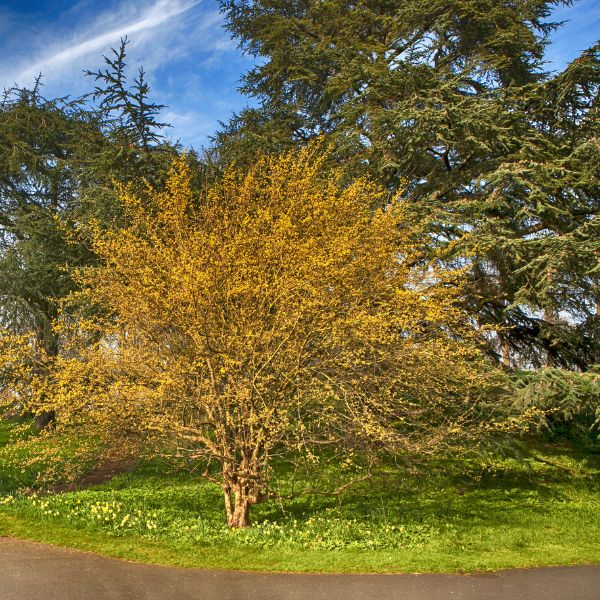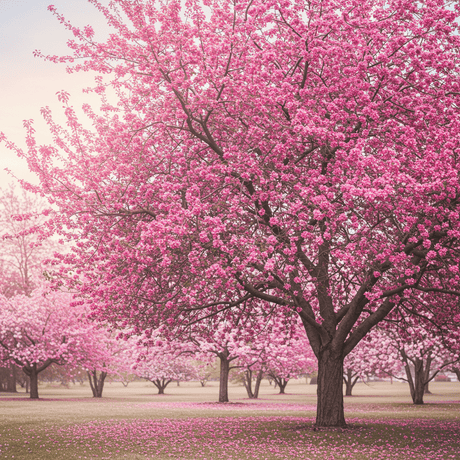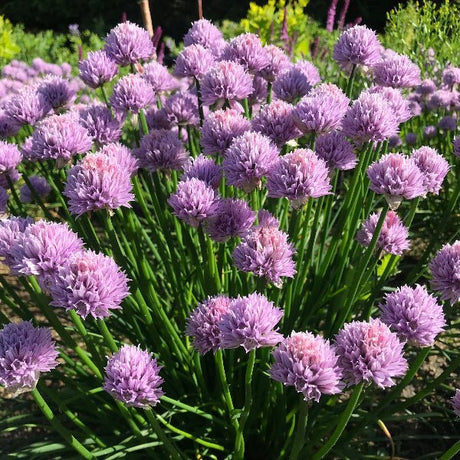Cornelian Cherry
Cornus mas
- Stay Protected with Plant Sentry ™
Cornelian Cherry - #3 Container 2-3 Feet Multi Stem is backordered and will ship as soon as it is back in stock.
Plant Sentry™
Plant Sentry™

Plant Sentry™ Protected
Your order is protected by our compliance system that:
- Prevents restricted plants from shipping to your state
- Ensures plants meet your state's agricultural requirements
- Protects gardens from invasive pests and diseases
Delivery and Shipping
Delivery and Shipping
Delivery and Shipping
Fast, Safe Plant Delivery
Ships in 3-4 business days • Tracking provided • Weather protected
| Under $50 | $9.99 |
| $50 - $99.99 | $14.99 |
| $100 - $149.99 | $16.99 |
| $150 - $198.99 | $24.99 |
| $199+ | FREE |
✓ Zone-specific timing • ✓ Professional packaging • ✓ Health guarantee
Understanding Plant Options
Nature Hills offers plants in two main formats:
- Container Plants: Grown in pots with soil, sized by container volume and plant age
- Bare Root Plants: Dormant plants without soil, sized by height measurements
Container Plant Sizes
Container sizes indicate plant age and growing capacity rather than liquid volume equivalents. Our containers follow industry-standard nursery "trade gallon" specifications, which differ from standard liquid gallon measurements.
Young Plants (6 months to 18 months old)
| Container Size | Actual Volume | Metric Equivalent |
|---|---|---|
| 2" x 2" x 3" | 0.18 - 0.21 dry quarts | 0.20 - 0.23 dry liters |
| 4" Container | 0.31 - 0.87 dry quarts | 0.35 - 0.96 dry liters |
| 4.5" Container | 0.65 dry quarts | 0.72 dry liters |
| 6" Container | 1.4 dry quarts | 1.59 dry liters |
| 1 Quart | 1 dry quart | 1.1 dry liters |
| 5.5" Container | 1.89 dry quarts | 2.08 dry liters |
Established Plants (18 months to 2.5 years old)
| Container Size | Actual Volume | Metric Equivalent |
|---|---|---|
| 2 Quart | 2 dry quarts | 2.2 dry liters |
| #1 Container | 2.26 - 3.73 dry quarts | 2.49 - 4.11 dry liters |
| 5" x 5" x 12" | 3.5 - 4.3 dry quarts | 3.85 - 4.74 dry liters |
Mature Plants (2-4 years old)
| Container Size | Actual Volume | Metric Equivalent |
|---|---|---|
| #2 Container | 1.19 - 1.76 dry gallons | 5.24 - 7.75 dry liters |
| #3 Container | 2.15 - 2.76 dry gallons | 8.14 - 12.16 dry liters |
Large Plants (3-5 years old)
| Container Size | Actual Volume | Metric Equivalent |
|---|---|---|
| #5 Container | 2.92 - 4.62 dry gallons | 12.86 - 20.35 dry liters |
| #6 Container | 5.25 - 6.01 dry gallons | 23.12 - 26.42 dry liters |
| #7 Container | 5.98 - 6.53 dry gallons | 26.34 - 28.76 dry liters |
Bare Root Plants
Bare root plants are sold by height from the root system to the top of the plant. Plants may exceed minimum height requirements.
Common Sizes:
- Trees: 1 foot, 2 feet, 3 feet, 4 feet, 5 feet, 6 feet
- Shrubs & Perennials: 1 foot, 18 inches, 2 feet
Important Notes
Container Volume Specifications
- Trade Gallon Standard: Our containers follow industry-standard "trade gallon" specifications established by the American National Standards Institute (ANSI Z60.1) for nursery stock
- Volume Variations: Actual soil volume may vary due to plant root systems and growing medium settlement
- Age Indicators: Container size primarily indicates plant age and maturity rather than liquid volume equivalents
Growing Conditions
- Plant size can vary based on variety and growing conditions
- Container size helps indicate plant maturity and establishment level
- Larger containers generally mean more established root systems and faster landscape establishment
Seasonal Availability
- Bare root plants are available seasonally when dormant
- Container plants are available throughout the growing season
- Specific varieties may have limited availability in certain sizes
Questions?
For questions about specific plant sizes or availability, please contact our plant experts who can help you choose the right size for your landscape needs.
Plant Highlights
Cornelian Cherry highlights at a glance!
-
Botanical Name
-
Brand
-
Growing Zones4, 5, 6, 7, 8
-
Growth RateModerate
-
Mature Height
-
Mature Width
-
Leaf Color
-
Flower Color
-
Pollinator FriendlyYes
-
Bloom PeriodEarly Spring
-
FragrantYes
-
Does Not Ship To
Characteristics
Where To Plant
When To Prune
- Early Spring
Water & Moisture Needs
- Moderate
Sunlight Needs
Soil Needs
- Well Drained Soil
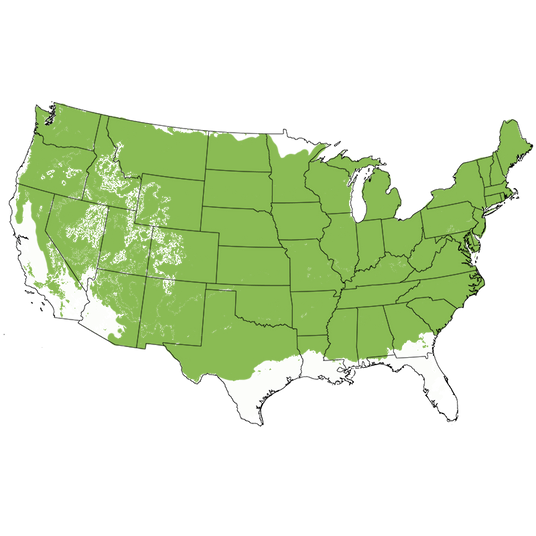
Growing Zones
Cornelian Cherry: Hardy, Early-Blooming Dogwood
The Cornelian Cherry or Cornealian Dogwood (Cornus mas) is a lesser-known gem in the Dogwood family, celebrated for its cheerful early yellow blooms, edible fruits, and hardiness! This deciduous large shrub or small tree blooms in late winter (in warm climates) to very early spring—often before anything else in the garden even wakes up. Its petite golden blossoms arrive in clusters before leaves appear, lighting up the landscape with sunshine-colored confetti!
Though not fragrant, it’s beloved by early pollinators and offers a bonus in late summer: tart, bright red fruits that resemble olives and are perfect for jams and preserves. Fruits appear in July to September and can persist into autumn if birds don’t nab them first! They're rich in vitamin C and loved in Eastern European cuisines.
Leaves are opposite, egg-shaped, dark green, and turn shades of maroon to purplish-red in the fall! Forming an upright, rounded shape, the Cornelian Cherry typically grows 15-25 feet tall and about 12-20 feet wide. It has a multi-stemmed branching that extends to the ground unless pruned into tree form, exposing the lower trunk. The bark exfoliates into mosaic-like patches on older plants—lovely in the winter garden!
>>Jump to Planting & Care Instructions
Key Features
- Blooms in late winter to early spring before leaves emerge
- Self-fruitful - Edible red fruits in late summer; great for preserves
- Grows as a multi-stemmed shrub or can be pruned into a small tree
- Attractive exfoliating bark on mature specimens
- Excellent cold hardiness and disease resistance
Supports early-season pollinators - Tolerates clay and urban conditions
Landscaping Uses
Native to central and southern Europe and western Asia, Cornus mas has been cultivated since ancient times, especially in the Balkans, where it’s prized both ornamentally and medicinally. A close cousin to our native Flowering Dogwood (Cornus florida), this species is tougher and blooms much earlier.
Use this rugged yet refined plant as a small ornamental tree or large screening shrub. It thrives in USDA Zones 4–8, tolerates urban conditions and clay soils, and can adapt to drought or high humidity once established. This old-world charmer is as practical as it is pretty!
- Hedge or screen with seasonal interest and wildlife appeal
- Small multi-purpose ornamental tree for front yards
- Specimen tree in mixed borders
- Early-season pollinator support in edible landscapes
- Fruit tree hedgerows, edible landscaping, or permaculture orchards
- Urban gardens that require especially resilient trees due to pollution
- Wildlife gardens (birds love the fruit)
Care and Maintenance
This deciduous small tree or large shrub is exceptionally durable—cold-hardy, sun-loving, and adaptable to varied soils.
- Planting Time: Best planted in spring or fall
- Sun Needs: Full sun to part shade
-
Soil Needs: Prefers well-drained soil; tolerates clay, rocky, and urban soils
Moisture Needs: Moderate water; drought-tolerant once established - Mulch: 3–4 inch layer of bark mulch or arborist chips; compost enriches soil
- Fertilization Needs: Light feeding in early spring; compost or balanced slow-release fertilizer
- Pruning Info: Blooms on old wood; prune after flowering if shaping is needed
- Renewal Pruning: Optional; can rejuvenate old shrubs over several seasons
- Special Needs/Perks:
- Deer and rabbit-resistant
- Urban environment-tolerant
- Handles compacted soil and light salinity
- Chill Hours: Roughly 800–1,000 hours if growing for fruit
Pollination Needs: Self-fertile but produces more fruit when cross-pollinated with another Cornus mas.
Cherry-Pick This Underrated Dogwood Delight
The Cornelian Cherry Tree or shrub brings bold color when you need it most—late winter into spring—and rewards again with edible summer fruits and fiery fall foliage. Hardy, handsome, and hassle-free, it’s a year-round performer with old-world charm.
Order now at Nature Hills Nursery, and we’ll ship at the proper planting time for your region!
Frequently Asked Questions
Is Cornelian Cherry Dogwood deer resistant?
Yes! Deer tend to leave it alone, making it a great choice for woodland edge plantings.
When does the Cornelian Cherry Dogwood bloom?
It blooms in late winter to very early spring, often February to March, depending on your region.
Can you eat Cornelian Cherry Dogwood fruit?
Yes! The red fruits are edible and high in vitamin C. They're tart when raw but great in jams, syrups, or dried like cranberries.
How fast does Cornus mas grow?
It’s a moderate grower—expect about 12–18 inches of growth per year once established in optimal conditions.
Does Cornus mas need a pollinator?
It is self-fertile, but planting more than one will improve fruit production.
How is Cornelian Cherry Dogwood different from American Dogwood?
It blooms earlier, is more tolerant of tough soils and climates, and produces edible fruit. Its flowers are smaller but more numerous and yellow instead of white or pink.
Is Cornelian Cherry Dogwood good for wildlife?
Absolutely. Birds adore the fruit, and the early flowers are an important nectar source for bees.
How do I prune a Cornelian Cherry Dogwood into a tree form?
Select a central leader early and prune away lower branches annually until a tree shape is formed.



